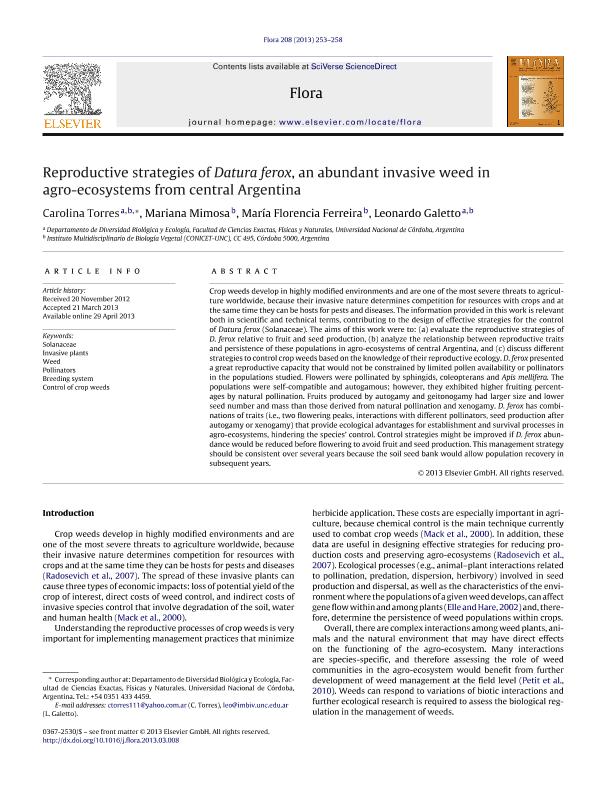Mostrar el registro sencillo del ítem
dc.contributor.author
Torres, Carolina Cecilia

dc.contributor.author
Mimosa, Mariana
dc.contributor.author
Ferreira, María Florencia

dc.contributor.author
Galetto, Leonardo

dc.date.available
2016-12-19T19:48:45Z
dc.date.issued
2013-04
dc.identifier.citation
Torres, Carolina Cecilia; Mimosa, Mariana; Ferreira, María Florencia; Galetto, Leonardo; Reproductive strategies of Datura ferox L., an abundant invasive weed in agro-ecosystems from central Argentina.; Elsevier Gmbh; Flora; 208; 4; 4-2013; 253-258
dc.identifier.issn
0367-2530
dc.identifier.uri
http://hdl.handle.net/11336/9770
dc.description.abstract
Crop weeds develop in highly modified environments and are one of the most severe threats to agricul-ture worldwide, because their invasive nature determines competition for resources with crops and atthe same time they can be hosts for pests and diseases. The information provided in this work is relevantboth in scientific and technical terms, contributing to the design of effective strategies for the controlof Datura ferox (Solanaceae). The aims of this work were to: (a) evaluate the reproductive strategies ofD. ferox relative to fruit and seed production, (b) analyze the relationship between reproductive traitsand persistence of these populations in agro-ecosystems of central Argentina, and (c) discuss differentstrategies to control crop weeds based on the knowledge of their reproductive ecology. D. ferox presenteda great reproductive capacity that would not be constrained by limited pollen availability or pollinatorsin the populations studied. Flowers were pollinated by sphingids, coleopterans and Apis mellifera. Thepopulations were self-compatible and autogamous; however, they exhibited higher fruiting percent-ages by natural pollination. Fruits produced by autogamy and geitonogamy had larger size and lowerseed number and mass than those derived from natural pollination and xenogamy. D. ferox has combi-nations of traits (i.e., two flowering peaks, interactions with different pollinators, seed production afterautogamy or xenogamy) that provide ecological advantages for establishment and survival processes inagro-ecosystems, hindering the species? control. Control strategies might be improved if D. ferox abun-dance would be reduced before flowering to avoid fruit and seed production. This management strategyshould be consistent over several years because the soil seed bank would allow population recovery insubsequent years.
dc.format
application/pdf
dc.language.iso
eng
dc.publisher
Elsevier Gmbh

dc.rights
info:eu-repo/semantics/openAccess
dc.rights.uri
https://creativecommons.org/licenses/by-nc-nd/2.5/ar/
dc.subject
Invasive Plants
dc.subject
Weed
dc.subject
Pollinators
dc.subject
Breeding System
dc.subject
Control of Crop Weeds
dc.subject.classification
Ecología

dc.subject.classification
Ciencias Biológicas

dc.subject.classification
CIENCIAS NATURALES Y EXACTAS

dc.title
Reproductive strategies of Datura ferox L., an abundant invasive weed in agro-ecosystems from central Argentina.
dc.type
info:eu-repo/semantics/article
dc.type
info:ar-repo/semantics/artículo
dc.type
info:eu-repo/semantics/publishedVersion
dc.date.updated
2016-12-12T14:16:18Z
dc.journal.volume
208
dc.journal.number
4
dc.journal.pagination
253-258
dc.journal.pais
Alemania

dc.journal.ciudad
Berlin
dc.description.fil
Fil: Torres, Carolina Cecilia. Consejo Nacional de Investigaciones Científicas y Técnicas. Centro Científico Tecnológico Córdoba. Instituto Multidisciplinario de Biología Vegetal (p); Argentina. Universidad Nacional de Córdoba. Facultad de Ciencias Exactas, Físicas y Naturales; Argentina
dc.description.fil
Fil: Mimosa, Mariana. Universidad Nacional de Córdoba. Facultad de Ciencias Exactas, Físicas y Naturales; Argentina
dc.description.fil
Fil: Ferreira, María Florencia. Universidad Nacional de Córdoba. Facultad de Ciencias Exactas, Físicas y Naturales; Argentina
dc.description.fil
Fil: Galetto, Leonardo. Consejo Nacional de Investigaciones Científicas y Técnicas. Centro Científico Tecnológico Córdoba. Instituto Multidisciplinario de Biología Vegetal (p); Argentina. Universidad Nacional de Córdoba. Facultad de Ciencias Exactas, Físicas y Naturales; Argentina
dc.journal.title
Flora

dc.relation.alternativeid
info:eu-repo/semantics/altIdentifier/doi/http://dx.doi.org/10.1016/j.flora.2013.03.008
dc.relation.alternativeid
info:eu-repo/semantics/altIdentifier/url/http://www.sciencedirect.com/science/article/pii/S0367253013000376
Archivos asociados
